#Bollandist
Text
Sexy TS masturbates and toys her wet ass
Ebony BBW Loves Deep Doggy
rubia follando cono mojado zorrita
cutecdx cumming handsfree
Madura antes de ducharse
Smoking hot hooker gets her sweet shaved snatch banged hard
Flat chested ladyboy teen MMF fucked like a total slut
ميمة مغربية تحشي الرجل ديال نموسية الفيديو كامل الرابط اسفل الفيديو
hot tranny fucks guy Natassia Dreams Booty Call
Safadinha gosta no cu e na buceta
#Australia#phrarisaical#Bollandist#popsicle#bolita#vesselful#XQ#bridewell#aahs#permissibleness#exauguration#physiatric#Sukin#edenite#Mitilni#demulcent#eye-splice#proo#deliberative#bibliotaph
0 notes
Text
Step brother caught wife fucking step sister and joins in
Naked BTS From Mina Moon in SICCOS, Discussions From the Shoot, Full Film At CaptiveClinicCom
Nasty nurse shoving big dildo in her ass
Hot College Girls Fucked on Snapchat
finger orgasam
Hot amateur brunette Anyah please her bald juicy pussy with pink dildo and nasty vibrator
کس من داره میترکه کیر عرفانو میخواد Masturbation
Asian thighjob
Desi indian wife big ass nice ass
Club sex muscle gay Ryan loves it when Kellan rubs his balls and
#six-story#well-whipped#Barayon#ciudad#Australia#phrarisaical#Bollandist#popsicle#bolita#vesselful#XQ#bridewell#aahs#permissibleness#exauguration#physiatric#Sukin#edenite#Mitilni#demulcent
0 notes
Text
The ‘Real’ St. Valentine Was No Patron of Love | Ancient Origins
https://www.ancient-origins.net/history-ancient-traditions/st-valentine-martyrs-0011479
View On WordPress
#11th century#1643#1940#3rd century#496AD#Acts Sanctorum#Africa#Asterius#Bollandists#Brittany#Cult#Decapitation#February 14#Jean Bolland#Jesuit#Liturgical Feast#Lupercalia#Martyr#Pope Geladius#relics#Rimini#Roman#Roman Emperor Claudius Gothicus#Skull#St. Augustine#St. Valentine#Terni#Umbria#Valentini#Via Fleminia
0 notes
Text
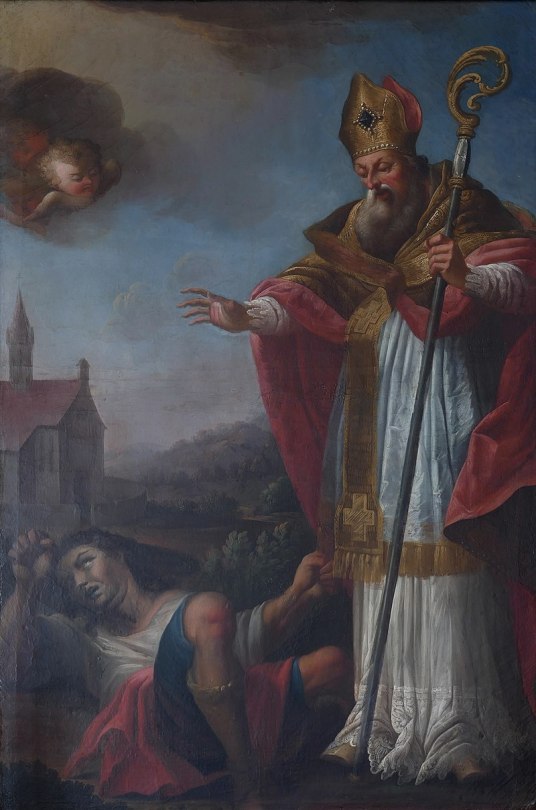
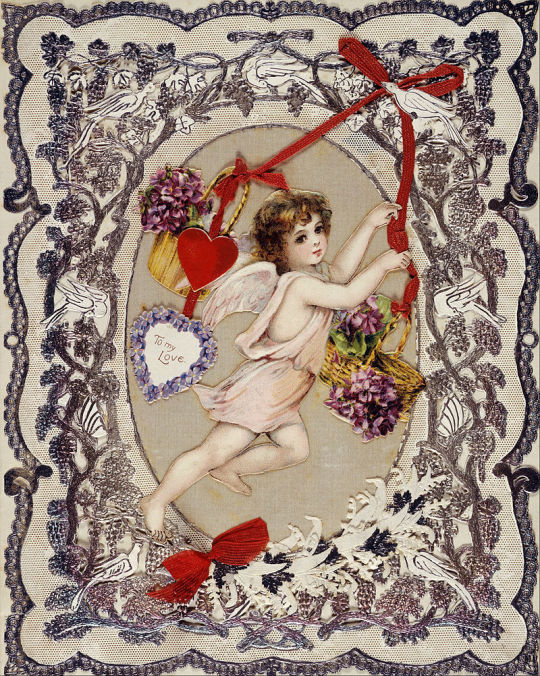

The ‘Real’ St. Valentine Was No Patron of Love
Valentine's Day originated as a feast to celebrate the decapitation of a third-century Christian martyr, or perhaps two. It took a gruesome path to becoming a romantic holiday.
The Conversation Lisa Bitel
On Feb. 14, sweethearts of all ages will exchange cards, flowers, candy, and more lavish gifts in the name of St. Valentine. But as a historian of Christianity, I can tell you that at the root of our modern holiday is a beautiful fiction. St. Valentine was no lover or patron of love.
Valentine’s Day, in fact, originated as a liturgical feast to celebrate the decapitation of a third-century Christian martyr, or perhaps two. So, how did we get from beheading to betrothing on Valentine’s Day?
Early Origins of St. Valentine
Ancient sources reveal that there were several St. Valentines who died on Feb. 14. Two of them were executed during the reign of Roman Emperor Claudius Gothicus in 269-270 A.D., at a time when persecution of Christians was common.
How do we know this? Because, an order of Belgian monks spent three centuries collecting evidence for the lives of saints from manuscript archives around the known world.
They were called Bollandists after Jean Bolland, a Jesuit scholar who began publishing the massive 68-folio volumes of “Acta Sanctorum,” or “Lives of the Saints,” beginning in 1643.
Since then, successive generations of monks continued the work until the last volume was published in 1940. The Brothers dug up every scrap of information about every saint on the liturgical calendar and printed the texts arranged according to the saint’s feast day.
The Valentine Martyrs
The volume encompassing Feb. 14 contains the stories of a handful of “Valentini,” including the earliest three of whom died in the third century.
The earliest Valentinus is said to have died in Africa, along with 24 soldiers. Unfortunately, even the Bollandists could not find any more information about him. As the monks knew, sometimes all that the saints left behind was a name and day of death.
We know only a little more about the other two Valentines.
According to a late medieval legend reprinted in the “Acta,” which was accompanied by Bollandist critique about its historical value, a Roman priest named Valentinus was arrested during the reign of Emperor Gothicus and put into the custody of an aristocrat named Asterius.
As the story goes, Asterius made the mistake of letting the preacher talk. Father Valentinus went on and on about Christ leading pagans out of the shadow of darkness and into the light of truth and salvation. Asterius made a bargain with Valentinus: If the Christian could cure Asterius’s foster-daughter of blindness, he would convert. Valentinus put his hands over the girl’s eyes and chanted:
“Lord Jesus Christ, en-lighten your handmaid, because you are God, the True Light.”
Easy as that. The child could see, according to the medieval legend. Asterius and his whole family were baptized. Unfortunately, when Emperor Gothicus heard the news, he ordered them all to be executed. But Valentinus was the only one to be beheaded. A pious widow, though, made off with his body and had it buried at the site of his martyrdom on the Via Flaminia, the ancient highway stretching from Rome to present-day Rimini. Later, a chapel was built over the saint’s remains.
St. Valentine Was Not a Romantic
The third third-century Valentinus was a bishop of Terni in the province of Umbria, Italy.
According to his equally dodgy legend, Terni’s bishop got into a situation like the other Valentinus by debating a potential convert and afterward healing his son. The rest of story is quite similar as well: He too, was beheaded on the orders of Emperor Gothicus and his body buried along the Via Flaminia.
It is likely, as the Bollandists suggested, that there weren’t actually two decapitated Valentines, but that two different versions of one saint’s legend appeared in both Rome and Terni.
Nonetheless, African, Roman or Umbrian, none of the Valentines seems to have been a romantic.
Indeed, medieval legends, repeated in modern media, had St. Valentine performing Christian marriage rituals or passing notes between Christian lovers jailed by Gothicus. Still other stories romantically involved him with the blind girl whom he allegedly healed. Yet none of these medieval tales had any basis in third-century history, as the Bollandists pointed out.
📷St. Valentine baptizing St. Lucilla. Credit: Jacopo Bassano (Jacopo da Ponte).
In any case, historical veracity did not count for much with medieval Christians. What they cared about were stories of miracles and martyrdoms, and the physical remains or relics of the saint. To be sure, many different churches and monasteries around medieval Europe claimed to have bits of a St. Valentinus’ skull in their treasuries.
Santa Maria in Cosmedin in Rome, for example, still displays a whole skull. According to the Bollandists, other churches across Europe also claim to own slivers and bits of one or the other St. Valentinus’ body: For example, San Anton Church in Madrid, Whitefriar Street Church in Dublin, the Church of Sts. Peter and Paul in Prague, Saint Mary’s Assumption in Chelmno, Poland, as well as churches in Malta, Birmingham, Glasgow, and on the Greek isle of Lesbos, among others.
For believers, relics of the martyrs signified the saints’ continuing their invisible presence among communities of pious Christians. In 11th-century Brittany, for instance, one bishop used what was purported to be Valentine’s head to halt fires, prevent epidemics, and cure all sorts of illnesses, including demonic possession.
As far as we know, though, the saint’s bones did nothing special for lovers.
Unlikely Pagan Origins
Many scholars have deconstructed Valentine and his day in books, articles and blog postings. Some suggest that the modern holiday is a Christian cover-up of the more ancient Roman celebration of Lupercalia in mid-February.
Lupercalia originated as a ritual in a rural masculine cult involving the sacrifice of goats and dogs and evolved later into an urban carnival. During the festivities half-naked young men ran through the streets of Rome, streaking people with thongs cut from the skins of newly killed goats. Pregnant women thought it brought them healthy babies. In 496 A.D., however, Pope Gelasius supposedly denounced the rowdy festival.
Still, there is no evidence that the pope purposely replaced Lupercalia with the more sedate cult of the martyred St. Valentine or any other Christian celebration.
Chaucer and the Love Birds
The love connection probably appeared more than a thousand years after the martyrs’ death, when Geoffrey Chaucer, author of “The Canterbury Tales” decreed the February feast of St. Valentinus to the mating of birds. He wrote in his “Parlement of Foules”:
“For this was on seynt Volantynys day. Whan euery bryd comyth there to chese his make.”
It seems that, in Chaucer’s day, English birds paired off to produce eggs in February. Soon, nature-minded European nobility began sending love notes during bird-mating season. For example, the French Duke of Orléans, who spent some years as a prisoner in the Tower of London, wrote to his wife in February 1415 that he was “already sick of love” (by which he meant lovesick.) And he called her his “very gentle Valentine.”
English audiences embraced the idea of February mating. Shakespeare’s lovestruck Ophelia spoke of herself as Hamlet’s Valentine.
In the following centuries, Englishmen and women began using Feb. 14 as an excuse to pen verses to their love objects. Industrialization made it easier with mass-produced illustrated cards adorned with smarmy poetry. Then along came Cadbury, Hershey’s, and other chocolate manufacturers marketing sweets for one’s sweetheart on Valentine’s Day.📷Valentine’s Day chocolates. Credit: GillianVann / Shutterstock.com.Today, shops everywhere in England and the U.S. decorate their windows with hearts and banners proclaiming the annual Day of Love. Merchants stock their shelves with candy, jewelry and Cupid-related trinkets begging “Be My Valentine.” For most lovers, this request does not require beheading.
Invisible Valentines
It seems that the erstwhile saint behind the holiday of love remains as elusive as love itself. Still, as St. Augustine, the great fifth-century theologian and philosopher argued in his treatise on “Faith in Invisible Things,” someone does not have to be standing before our eyes for us to love them.
And much like love itself, St. Valentine and his reputation as the patron saint of love are not matters of verifiable history, but of faith.
Lisa Bitel is Professor of History & Religion at the University of Southern California’s Dornsife College of Letters, Arts and Sciences.
https://getpocket.com/explore/item/the-real-st-valentine-was-no-patron-of-love?utm_source=pocket-newtab
0 notes
Text
St. George, Christian, soldier, dragon slayer, martyr
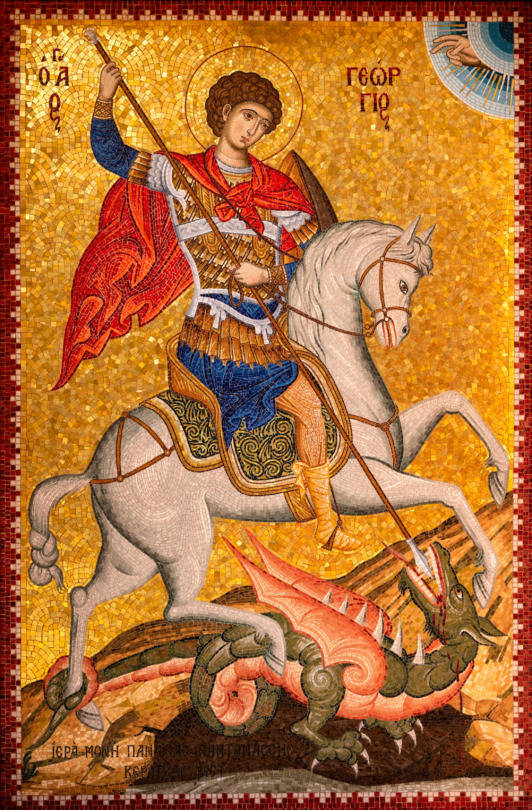
Feast day(s): April 23rd (Catholic) April 23rd, November 26th, November 3rd (Russian Ortho) November 17th, May 1st (Coptic Ortho)
Patronage: soldiers, archers, cavalry and chivalry, farmers and field workers, riders and saddlers, those suffering from leprosy, plague and syphilis.
It is uncertain when Saint George was born and historians continue to debate to this day. However, his death date is estimated to be April 23 303 A.D.
The first piece of evidence of George's existance appeared within the works of the Bollandists Daniel Papebroch, Jean Bolland, and Godfrey Henschen's Bibliotheca Hagiographica Graeca. George was one of several names listed in the historical text, and Pope Gelasius claimed George was one of the saints "whose names are justly reverenced among men, but whose actions are known only to God."
George was born to a Gerontios and Polychronia, a Roman officer and a Greek native of Lydda. Both were Christians from noble families of the Anici and George, Georgios in the original Greek, was raised to follow their faith.
When George was old enough, he was welcomed into Diocletian's army. by his late 20's, George became a Tribunus and served as an imperial guard for the Emperor at Nicomedia.
On February 24, 303 A.D., Diocletian, who hated Christians, announced that every Christian the army passed would be arrested and every other soldier should offer a sacrifice to the Roman gods.
George refused to abide by the order and told Diocletian, who was angry but greatly valued his friendship with George's father.
When George announced his beliefs before his peers, Diocletian was unable to keep the news to himself.
In an effort to save George, Diocletian attempted to convert him to believe in the Roman gods, offered him land, money and slaves in exchange for offering a sacrifice to the Roman gods, and made several other offers that George refused.

Finally, after exhausting all other options, Diocletian ordered George's execution. In preparation for his death, George gave his money to the poor and was sent for several torture sessions. He was lacerated on a wheel of swords and required resuscitation three times, but still George did not turn from God.
On April 23, 303 A.D., George was decapitated before Nicomedia's outer wall. His body was sent to Lydda for burial, and other Christians went to honor George as a martyr.
Saint George and the Dragon
There are several stories about George fighting dragons, but in the Western version, a dragon or crocodile made its nest at a spring that provided water to Silene, believed to be modern-day Lcyrene in Libya.
The people were unable to collect water and so attempted to remove the dragon from its nest on several ocassions. It would temporarily leave its nest when they offered it a sheep each day, until the sheep disappeared and the people were distraught.
This was when they decided that a maiden would be just as effective as sending a sheep. The townspeople chose the victim by drawing straws. This continued until one day the princess' straw was drawn.
The monarch begged for her to be spared but the people would not have it. She was offered to the dragon, but before she could be devoured, George appeared. He faced the dragon, protected himself with the sign of the Cross, and slayed the dragon.
After saving the town, the citizens abandoned their paganism and were all converted to Christianity.
Interesting Facts
Saint George stands out among other saints and legends because he is known and revered by both Muslims and Christians.
It is said Saint George killed the dragon near the sea in Beirut, thus Saint George bay was named in his honor.
Saint George's feast day is celebrated on April 23, but if it falls before Easter, it is celebrated Easter Monday.
The Russian Orthodox Church celebrates three St. George feast days each year -April 23 as is expected, November 3, to commemorate the consecration of a cathedral dedicated to him in Lydda, and on November 26, for when a church in Kiev was dedicated to him.
In older works, Saint George is depicted wearing armor and holding a lance or fighting a dragon, which represents Christ's enemies.
In Bulgaria, his feast day is celebrated May 6 with the slaughter and roasting of a lamb.
In Egypt, the Coptic Orthodox Church of Alexandria calls St. George the "Prince of Martyrs" and celebrates on May 1. There is a second celebration November 17, in honor of the first church dedicated to him.
Saint George is the patron saint of England and Catalonia and his cross can be found throughout England.
#catholic#russian orthodox#coptic orthodox#st george#st george and the dragon#christian#catholic history#history#saints
87 notes
·
View notes
Text
Free! Database of manuscripts containing Latin Saint's Lives - at the Bollandists
Free! Database of manuscripts containing Latin Saint’s Lives – at the Bollandists

I’ve been looking for manuscripts of the “Life” of St Nicholas by John the Deacon. In the process I have just come across something very useful.
This is the “Bibliotheca Hagiographica Latina Online” (although it doesn’t contain the BHL info) or Bibliotheca Hagiographica Latina manuscripta (BHLms) database. And … it is free! You have to enter your name and email address,but then you can do what…
View On WordPress
0 notes
Text
SAINT OF THE DAY (December 18)
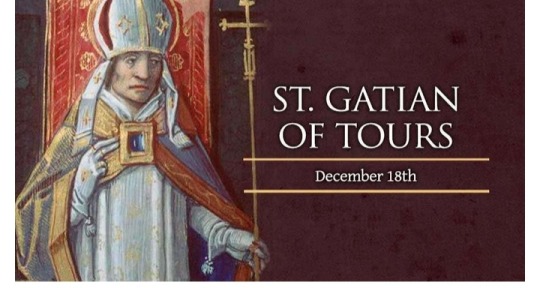
Saint Gatian (Gatianus of Tours), who lived in the third century, was the founder and bishop of Tours.
He came to Gaul with Saint Dionysius of Paris during the consulate of Decius and Gratus around the year 250.
A most pious man and a true disciple of Christ, Gatian spent the next fifty years evangelizing this pagan area.
Because the people were so ingrained in their idolatry of false gods, his evangelization efforts were not only difficult but also dangerous.
He underwent much persecution and threats were constantly being made on his life.
Many masses were held in grottos and caves where he would gather his converts to celebrate the mysteries of the faith.
Despite all the obstacles he encountered while spreading the Gospel, he persevered.
He didn’t fear his persecutors, for he did not value his life above bringing souls to Christ.
He was always ready to lay down his life for the faith.
Some legends claim that Saint Gatian was one of the seventy-two disciples of Christ and that Saint Peter himself had sent him to Gaul during the first century.
This would mean, of course, that he lived at an earlier time than we have recorded.
However, Gregory of Tours, a bishop who lived in the sixth century, refutes this story in his writings.
Source: Catholic Exchange
-----------
The holy bishop Gatian died at an advanced age (d. 337), having seen Our Lord Jesus Christ come to him during his last illness to awake him from sleep and give him Holy Communion in Viaticum.
He died seven days later.
The Cathedral of Tours still possesses a few fragments of his relics, which Saint Martin had placed in that principal church, but which wars and persecutions scattered and destroyed in large part.
Les Petits Bollandistes: Vies des Saints, by Msgr. Paul Guérin (Bloud et Barral: Paris, 1882), Vol. 14
Source: sanctoral.com
9 notes
·
View notes
Text
surfing the web, found something of interest to read as she sources heavy from a book I have been trying to find
Irish Saints of July Irish Saints in July (Magdalene Rock)
About Me
Marcella
I am an Irishwoman interested in the lives of our native saints and martyrs. I am not a professional scholar in this field but attempt to keep up with the work of those who are. I am particularly interested in the many obscure Irish saints whose names fill the pages of our Martyrologies.
View my complete profile
About this Blog
Omnium Sanctorum Hiberniae is dedicated to the saints of Ireland. The feast days of the saints are those recorded in the historic Irish calendars. These are not in every case the dates on which they are commemorated in the Church today.
Copyright Notice
This blog represents my original work, even where I have used public domain sources. I am happy for others to use the materials here provided they respect my right to my intellectual property by linking back to this site. This also applies where posts have been translated into other languages and published elsewhere.
O'Hanlon's Lives of the Irish Saints
One of the major sources used at this blog is the nine-volume
Lives of the Irish Saints
by John, Canon O'Hanlon (1821-1905). It is a work in the public domain and available through the
Internet Archive
. A post on the life and work of the 'Irish Bollandist' can be read here
De Processu Martyriali
De Processu Martyriali is my new blog dedicated to the Irish Martyrs of the Reformation period. Read it here
.
Trias Thaumaturga
Trias Thaumaturga is the sister blog to this site and houses an archive of posts specifically on the three wonderworking patron saints of Ireland, Saint Patrick, Saint Brigid and Saint Colum Cille. Visit it here.
1 note
·
View note
Photo
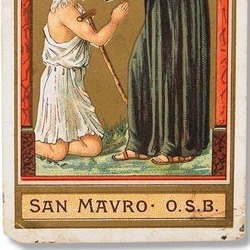
Story of St. Maurus - Feast Day - January 15th - Latin Calendar
Life of St. Maurus (Maur) (Order of St. Benedict)
St. Maurus, abbot and deacon, son of Equitius, a nobleman of Rome, was born about the year 510 and died in 584. When he was about twelve years old, his father placed him under the care of St. Benedict at Subiaco, to be educated in piety and learning. When he had grown up, St. Benedict chose him as his coadjutor in the government of the monastery. He was a model of perfection to all his brethren, but especially in the virtue of obedience.
St. Placid, one of his fellow disciples, the son of the senator Tertullus, going one day to draw water, fell into the lake, and was at once carried away by the current. St. Benedict saw this in spirit in his cell and bade Maurus run and draw him out. Having asked and received the holy Father's blessing, Maurus hastened down to the lake, walked upon the waters, thinking he was on dry land, and dragged Placid out by the hair, without sinking in the least himself. He attributed the miracle to the command and prayers of St. Benedict; but the holy abbot, to the obedience of the disciple.
St. Maurus was sent to France in 543 to propagate the order of St. Benedict in that country. He founded the famous abbey of Glanfeuil, over which he ruled as abbot for thirty-eight years. In 581 he resigned the abbacy, built for himself a small cell near the church of St. Martin, so that in solitude and prayer he might prepare himself for his passage into eternity. After two years he fell sick sof a fever: he received the sacraments of the Church, lying on sackcloth before the altar of St. Martin, and in that posture expired on January 15, 584.
Gift of Miracles
St. Maurus was favored by God with the gift of miracles. To show in what high degree the Saint possessed the gift of miracles, it will be sufficient to cite a few examples of how he miraculously cured the sick and restored to health those who were stricken with a grievous affliction. It has already been stated, according to the testimony of Pope St. Gregory the Great, in the Second Book of his Dialogues, how when a youth, St.Maurus rescued St. Placid from drowning.
A few more examples of miracles wrought by the Saint, as related by the monk St. Faustus (Bollandists, Vol. 2), who accompanied St. Maurus to France and later wrote his life, will be given here. They were invariably wrought by means of the sign of the Cross, and the relic of the true Cross, which he had taken along to France.
When St. Maurus, at that time prior of the abbey of Monte Cassino, was returning with the brethren from gathering the harvest in the fields, he met a boy who was mute and crippled, accompanied by his parents. When the father and mother of the boy cast themselves at the feet of the Saint and implored him to cure their child of his maladies, St. Maurus, having for some time given himself to prayer, imposed upon the head of the boy his levitical stole, for he was a deacon, and made the sign of the Cross over him, saying to him: "In the name of the most holy and undivided Trinity, and supported by the merits of the-most holy Father Benedict, I bid you to rise, stand upon your feet and be cured." And forthwith the boy arose, walked about, and with a loud voice praised and glorified God.
A certain Vicar, Ardenard, had been sent by Innocent, the Bishop of Mans, to Monte Cassino, in order to petition St. Benedict to send some monks to France. Arriving at a place called Vercella, the Vicar fell down headlong from a high stairway in the place where he was lodging. His body was so crushed by the fall that his life was despaired of. His right shoulder, arm and hand had so swelled with inflammation, that amputation of the arm was deemed necessary. Recourse was then had to their companion, St. Maurus, who was engaged in prayer in the oratory. Moved by the earnest supplications of his brethren, and the misery of the sick man, the Saint cast himself prostrate at the foot of the altar, pouring forth his soul in fervent prayer. Having finished praying, he took from the altar the case of relics which had been sent him by his master, St. Benedict, and went to the bedside of the sick man. Having exposed the relic of the Cross, he made the sign of the Cross over every part of the arm from the shoulder to the fingers, saying:
"O God, the Creator of all things, You ordained that Your only Son should take flesh of the Virgin Mary by the power of the Holy Spirit for the restoration of your people, and You deigned to heal the wounds and infirmities of our souls by the redemption accomplished upon the sacred and glorious wood of the life-giving Cross: do You also vouchsafe through this powerful sign to restore health to Your servant."
His prayer being ended, all the poisoned blood, by which the Vicar's arm had beer inflamed, began to flow off from three different places in his arm, and his arm was cured.
While continuing their journey and reaching the Alps, one of the servants, Sergius, riding on horseback, fell from his horse and struck his leg against a huge rock, and so crushed it that it was but one bruised mass. Whereupon St. Maurus went up to the unfortunate man, seized his crushed leg with his left hand, and with his right made the sign of the Cross over it, saying: "In the name of almighty God, arise and be cured," and immediately, to the joy of all, his crushed leg became whole and sound.
When St. Maurus and his little band came to the church of the holy martyrs Sts. Maurice and his companions, they entered it to pray. At the entrance of the church sat a certain man who was born blind, begging alms from those who entered and left the edifice. He had learned that Maurus, the disciple of the holy man Benedict, had arrived, the fame of his sanctity having already preceded him. When Maurus and his companions had finished their prayers and left the church, they found the blind man lying prostrate on the ground, begging and imploring the Saint to obtain for him by his prayers the light of his eyes. Maurus commanded him to rise, and pressing the fingers of his right hand upon his eyes, he imprinted on them the sign of our redemption. Thereupon the blind man instantly obtained his eyesight.
Maur Rescues Placid
Since St. Maurus miraculously freed many persons from their bodily afflictions through the sign of the Cross and the relic of the true Cross of Christ, in many monasteries of the Order of St. Benedict from time immemorial, after the example of this miracle-worker, the custom of blessing the sick with the relic of the true Cross, has prevailed, in order to restore their health. But until recent years, there was no uniform and approved formula of blessing of the Church. There existed a number of old and new formulas, which were essentially the same, but differed from each other in many details. Some formulas were exceedingly lengthy. In the face of these facts, the Rt. Rev. Dom Maurus Wolter OSB, President of the Beuronese Congregation, petitioned Rome for an approved and authentic formula. A carefully prepared and much abbreviated formula was therefore presented to the Sacred Congregation of Rites for its approval.
This formula was approved by the Sacred Congregation for all priests and deacons, secular as well as regular clerics, to impart the blessing, provided the formula approved by the Sacred Congregation is used.
Nihil obstat: John Eidenschink, OSB JCD, Censor deputatus. Imprimatur: + Peter W. Bartholome, DD, Bishop of St. Cloud, March 3, 1963.
The Blessing of Saint Maurus over the Sick
with a Relic of the True Cross or the Medal of Saint Benedict

Since it is frequently impossible to have a relic of the True Cross, the Sacred Congregation of Rites granted on 6 March 1959, at the request of Benno Cardinal Gut OSB, then Abbot Primate of the Order of St. Benedict, the permission to use the medal of St. Benedict in place of the relic of the True Cross to confer the Blessing of St. Maurus with the approved form as given below.
Efficacy of the Blessing
The blessing of Saint Maurus has its efficacy through the power of the sign of the Cross, the veneration of the relic of the true Cross of our Redeemer, the intercession of the Blessed Virgin Mary, St. Benedict and St. Maurus, and the blessing of the Church. Innumerable facts attest that where the blessing of St. Maurus has been received with a lively faith, sincere contrition, and firm confidence in God, persons have been relieved of their bodily ills, sicknesses have been cured, and evident miracles have been wrought.
Form of the Blessing
Before the blessing is imparted, the relic of the true Cross of our Lord or the medal of St. Benedict is exposed, at least two candles having been lit. Acts of contrition and firm confidence should then be excited in the sick person, so that through the merits and intercession of St. Benedict and St. Maurus, if it should please God, health may be obtained. Three Our Fathers, Hail Marys and Glory be's are recited in honor of the Blessed Trinity. Then a priest or deacon, having put on a stole, and with his right hand holding up the relic or the medal of St. Benedict before the sick person, says the following prayers:
V. Benediction and glory, and wisdom, and thanksgiving, honor and power and strength to our God forever and ever.
R. Amen.
V. My foot has stood in the direct way.
R. In the churches I will bless You, O Lord.
Invocation
Through the invocation of the most holy name of the Lord may that faith, in which St. Maurus, by employing the words that follow, healed the sick, and in which I, though an unworthy sinner, utter the selfsame words, restore your health as you desire:
In the name of the most holy and undivided Trinity and supported by the merits of the most holy Father Benedict, I bid you, N., to rise, stand upon your feet and be cured, in the name of the Father and of the Son + and of the Holy Spirit.
R. Amen.
Antiphon. Surely He has borne our infirmities and carried our sorrows: by His bruises we are healed.
V. He that forgives the iniquities of his creatures.
R. May He heal your infirmities.
V. O Lord, hear my prayer.
R. And let my cry come to You.
V. The Lord be with you.
R. And with your spirit.
Let us pray
O God, the Creator, of all things, You ordained that Your only Son should take flesh of the Virgin Mary by the power of the Holy Spirit for the restoration of your people and You deigned to heal the wounds and infirmities of our souls by the redemption accomplished upon the sacred and glorious wood of the life-giving Cross: do You also vouchsafe through this powerful sign to restore health to Your servant N.
Through the same Christ our Lord.
R. Amen.
Let us pray
Lord Jesus Christ, You conferred upon the master, blessed Benedict, the privilege of obtaining from You whatsoever he might ask in Your name: vouchsafe, through his intercession, to heal all the infirmities of this Your servant: in order that, being restored to health, he (she) may give thanks to Your holy name.
You live and reign with the Father and the Holy Spirit for ever and ever.
R. Amen.
The Blessing
Through the invocation of the Immaculate Mother of God and ever Virgin Mary, and the intercession of Saints Benedict and Maurus, may the Power + of God the Father, the Wisdom + of God the Son, and the Strength + of the Holy Spirit free you from your infirmities. Amen.
May God's holy will be done, and may it be done to you as you wish and pray, for the praise and honor of the most holy Cross of our Lord Jesus Christ.
The priest then blesses the sick person with the relic of the Cross or the medal of St. Benedict saying:
May the blessing of Almighty God, of the Father and of the Son + and of the Holy Spirit descend upon you and abide with you forever.
R. Amen.
The sick person then kisses the relic or the medal of St. Benedict.
This blessing, if need be, may be repeated three times; also three votive Masses may be celebrated, namely in honor of the Passion, of St. Maurus, Abbot, and for the Poor Souls; otherwise the fifteen decades of the Rosary of the Blessed Virgin Mary are to be prayed according to the aforesaid intentions by the sick person, or by others in the person's name.
Devotion to the Cross
The cross of Christ is the symbol of our redemption. By His death on the Cross, Christ redeemed the world and procured for us all blessings. We need not then be surprised to find among the Apostles a great love and veneration for the Cross. St. Paul says: "With Christ I am nailed to the Cross" (Gal. 2:19). And again: "God forbid that I should glory, save in the Cross of our Lord Jesus Christ, by whom the world is crucified to me, and I to the world" (Gal. 6:14).
This reverence for the Cross was passed on by the Apostles to the early Christians, for whom the Cross of our Savior was the special object of devotion. They carved it on their tombs, marked it on their houses, imprinted it on their clothing, and on household articles. They signed themselves with the sign of the Cross on coming and going, before beginning any work and upon ending it, and in all trials and dangers. They expected to obtain through the instrument of our redemption every blessing from God, especially protection against the assaults of the devil and all dangers of body and soul.
As the Cross of our Lord Jesus Christ was the chief object of devotion among the early Christians, so it was also with St. Benedict, the Patriarch of Western monasticism, and his disciples. St. Benedict often used the sign of the Cross to work miracles and to overcome the devil and his temptations; and it was this devotion of the Saint to the Cross that gave rise to the Cross or Medal of St. Benedict. The sons of St. Benedict have inherited this veneration and love of the Cross from their spiritual Father. We see this especially exemplified in the life of St. Maurus, a disciple of St. Benedict, who cherished a great devotion to the Cross of Christ, and who employed it as powerful means for curing the sick.
Nihil obstat: John Eidenschink, OSB JCD, Censor deputatus. Imprimatur: + Peter W. Bartholome, DD, Bishop of St. Cloud, March 3, 1963. HTML version: Tom Gillespie OSB; graphic: Placid Stuckenschneider OSB. Copyright 1963 by The Order of St. Benedict, Collegeville, Minnesota.
6 notes
·
View notes
Photo

Saint Hubertus or Hubert (c. 656 – 30 May 727) became Bishop of Liège in 708 AD.[1] He is a Christian saint who is the patron saint of hunters, mathematicians, opticians, and metalworkers. Known as the Apostle of the Ardennes, he was called upon, until the early 20th century, to cure rabies through the use of the traditional St Hubert's Key.[2]
Saint Hubertus was widely venerated during the Middle Ages. The iconography of his legend is entangled with the legend of Saint Eustace. The Bollandists published seven early lives of Hubertus (Acta Sanctorum, November, i., 759–930 AD); the first of these was the work of a contemporary, though it is very sparing of details.
He died 30 May 727 AD in or near a place called (in Latin) Fura. In the later Middle Ages, this place was identified as Tervuren near Brussels, Belgium, but recent scholarship considers Voeren/Fourons, between Maastricht and Liège, the likelier place.[3] His feast day is 3 November.
https://en.wikipedia.org/wiki/Hubertus
4 notes
·
View notes
Photo

Saint Thomas Becket
Archbishop of Canterbury, Martyr
(1117-1170)
Saint Thomas Becket
Saint Thomas, son of an English nobleman, Gilbert Becket, was born on the day consecrated to the memory of Saint Thomas the Apostle, December 21, 1117, in Southwark, England. He was endowed by both nature and grace with gifts recommending him to his fellow men; and his father, certain he would one day be a great servant of Christ, confided his education to a monastery. His first employment was in the government of the London police. There he was obliged to learn the various rights of the Church and of the secular arm, but already he saw so many injustices imposed upon the clergy that he preferred to leave that employment rather than to participate in iniquity. He was perfectly chaste and truthful, and no snares could cause to waver his hatred for any form of covert action.
He was employed then by the Archbishop of Canterbury, who sent him on missions to Rome and permitted him to study civil law at the University of Bologna (Italy) for an entire year. After a few years, witnessing his perfect service, he made him his Archdeacon and endowed him with several benefices. The young cleric's virtue and force soon recommended him also to the king, who made of him his Lord Chancellor. In that high office, while inflexible in the rendition of justice, he was generous and solicitous for the relief of misery. He was severe towards himself, spending the better part of every night in prayer. He often employed a discipline, to be less subject to the revolts of the flesh against the spirit. In a war with France he won the respect of his enemies, including that of the young king Louis VII. To Saint Thomas, his own sovereign, Henry II, confided the education of the crown prince. Of the formation of the future king and the young lords who composed his suite, the Chancellor took extreme care, knowing well that the strength of a State depends largely on the early impressions received by the elite of its youth.
When Archbishop Theobald of Canterbury died, the king insisted on the consecration of Saint Thomas in his stead. Saint Thomas at first declined, warning the king that from that hour their friendship would be threatened by his own obligations to uphold the rights of the Church against infringement by the sovereign, whose tendencies were not different from those of his predecessors. In the end he was obliged by obedience to yield. The inevitable conflict was not long in coming. Saint Thomas resisted when the king's courtiers drew up a list of royal customs at Clarendon, where the parliament of the king was assembled, and Henry obliged all the bishops as well as the lords to sign a promise to uphold these without permitting any restrictions whatsoever. Many of these pretended customs violated the liberties of the Church, and some were even invented for the occasion. Saint Thomas, obliged in conscience to resist, was soon the object of persecution, not only from the irritated king but by all who had sworn loyalty to his nefarious doings.
Saint Thomas took refuge in France under the protection of the generous Louis VII, who resisted successfully the repeated efforts of Henry to turn away his favor from the Archbishop... The Pope at that time was in France, and he, too, was besieged by Henry's emissaries, but knew well how to pacify minds and protect the defender of the Church. Thomas retired to a Benedictine monastery for two years, and when Henry wrote a threatening letter to its abbot, moved to another. After six years, his office restored as the Pope's apostolic legate, a title which Henry had wrested from him for a time, he returned to England, to preach again and enforce order in his see. He knew well that it was to martyrdom that he was destined; it is related that the Mother of God appeared to him in France to foretell it to him, and that She presented him for that intention with a red chasuble. By this time the persecuted Archbishop's case was known to all of Christian Europe, which sympathized with him and elicited from king Henry an appearance of conciliation.
A few words which the capricious Henry spoke to certain courtiers who hated Thomas, sufficed for the latter to decide to do away with the prelate who contravened all their unchristian doings. They violated a monastic cloister and chapel to enter there while he was assisting at Vespers; the Saint himself prevented the monks from resisting the assassins at the door. Refusing to flee the church as the assassins summoned him to do, he was slain before the altar, by cruel and murderous repeated blows on the head. He died, saying: I die willingly, for the name of Jesus and for the defense of the Church.
The actions of the Pope in this conflict make clear what all of history teaches: the lives of the Church's Saints themselves comprise the history of the world. The humility of Thomas had prompted him, after a moment of weakness he had manifested in a difficult situation, to judge himself unfit for his office and offer his resignation as Archbishop. The Pope did not hesitate a moment in refusing his resignation. He judged with apostolic wisdom that if Thomas should be deprived of his rank for having opposed the unjust pretensions of the English royalty, no bishop would ever dare oppose the impingements of iniquity on the Church's rights, and the Spouse of Christ would be no longer sustained by marble columns, but by reeds bending in the wind.
The martyred Archbishop was canonized by Pope Alexander III on Ash Wednesday, 1173, not yet three years after his death on December 29, 1170, to the edification of the entire Church.
Les Petits Bollandistes: Vies des Saints,
by Msgr. Paul Guérin (Bloud et Barral: Paris, 1882), Vol. 14
1 note
·
View note
Quote
...out of the approximately 14,000 saints whose biographies figure in the first six months of the Bollandists' writings, one finds only about sixty, that is 0.4 percent whose indices morales mention proven levitations, recorded and duly acknowledged only after being subjected to all the skeptical inquiries, depositions, and processes, clandestine investigations, cross-checkings, criticisms, judicial calls to order, and the famous animadversions of the Promoter of the Faith (The "Devil's Advocate"), which continue throughout the ages and are ceaselessly revised.
Blaise Cendrars, Sky
above parkour
1 note
·
View note
Photo
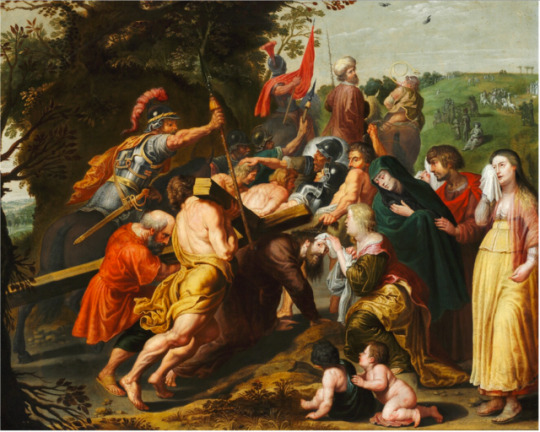
Gerard de la Vallee - The bearing of the cross and the meeting with Saint Veronica -
Saint Veronica was a woman of Jerusalem in the first century AD, according to Catholic tradition. A celebrated saint in many pious Christian countries, the Acta Sanctorum published by the Bollandists listed her feast under July 12, but the German Jesuit scholar Joseph Braun cited her commemoration in Festi Marianni on 13 January.
According to Church tradition, Veronica was moved with sympathy when she saw Jesus carrying his cross to Golgotha and gave him her veil that he might wipe his forehead. Jesus accepted the offering, held it to his face, and then handed it back to her—the image of his face miraculously impressed upon it. This piece of cloth became known as the Veil of Veronica.
The name "Veronica" itself is a Latinisation of Berenice (Greek: Βερενίκη, Berenikē, with a secondary form Beronike), a Macedonian name, meaning "bearer of victory". The woman who offered her veil to Jesus was known by this name in the Byzantine East, but in the Latin West the name took a life of its own.
There is no reference to the story of St Veronica and her veil in the canonical Gospels.
Gerard de la Vallée (1596/1597 – after 1667) was a Flemish painter of landscapes and history paintings. His work was inspired by the great Flemish masters and mainly produced for the export market.
20 notes
·
View notes
Photo

Plus de mille médecins belges sonnent l'alarme climatique
Dans les hôpitaux, les maisons médicales, les cabinets de généraliste ou les universités, des professionnels s'inquiètent.
L'été dernier, 716 décès supplémentaires ont été enregistrés en Belgique au cours des trois épisodes de fortes chaleurs qui ont frappé le pays. Associées à des pics d'ozone, les températures élevées contribuent à augmenter la mortalité. Et, selon les prévisions, ces phénomènes vont se multiplier et s'aggraver. Pourtant, l'intérêt pour les impacts sanitaires des dérèglements climatiques est discret chez nous. A tort, estiment près de mille médecins belges qui adressent une lettre ouverte aux autorités politiques et à la population.
Pour eux, le dérèglement climatique est une « urgence de santé publique ». Le stress thermique n'est pas le seul impact dont il faut se préoccuper, disent-ils. Il faut également s'inquiéter de «l'émergence dans nos régions de maladies transmises par les moustiques telles que le paludisme ou la dengue, (de) l'augmentation du nombre de naissances prématurées ou encore (de) l'augmentation des pathologies respiratoires d'origine allergique ». Ces pathologies «vont surcharger et compromettre la viabilité des systèmes de santé en Europe et dans le monde », alertent les signataires. Ces derniers fustigent « la faiblesse des réponses apportées jusqu'ici ». La Belgique « dont le taux d'émissions par habitant est parmi les plus élevés au monde - ne prend actuellement pas sa part de l'effort ». Cela « met la population en danger à court terme ».
« Il est encore temps de réagir »
Nous devons réduire plus volontairement nos émissions de gaz à effet de serre pour contribuer à un effort mondial qui devrait permettre d'éviter le pire du réchauffement, insistent ces professionnels de la santé. Il faut « désinvestir les moyens financiers publics des sociétés dont l'activité contribue au dérèglement climatique et à la dégradation de l'environnement, et les réinvestir dans le développement d'une économie soutenable faudra s'adapter aussi, bien que le sujet ne soit qu'effleuré dans la lettre. « Nous n'avons pas voulu apparaître comme des professionnels qui demandent plus de moyens pour leur secteur », explique David Hercot, médecin attaché à la commission communautaire commune à Bruxelles et l'un des initiateurs de la lettre. « Nous insistons sur la réduction drastique des émissions de gaz à effet de serre parce que chaque dixième de degré gagné ou perdu aura des répercussions pour la santé », pour-suit Maye Vandenbussche, médecin généraliste à Bruxelles. « Il y a plus de gains à attendre d'une lutte contre le réchauffement climatique. Nous sommes dans une période charnière, il faut mettre toutes les énergies à réduire les émissions avant de songer à s'adapter. C'est aussi une question de responsabilité dans nos pays riches, l'adaptation aux impacts du dérèglement climatique est plus facile. Réduire les émissions bénéficiera à tout le monde. » De sa pratique quotidienne remontent des constats « Les problèmes s'aggravent. Les pathologies respiratoires, les allergies chez les enfants... Des évolutions sensibles pour un généraliste. »
« Il est encore temps de réagir », estime Jean Macq, professeur à l'UCLouvain . « On peut faire des choses concrètes sans vivre moins bien. Les gens ne se rendent pas compte des conséquences des changements climatiques. La population vieillit. Et plus on vieillit, plus on est sensible aux maladies. Il y a un travail de conscientisation à faire. Et tous les segments de la société doivent bouger. »
Indispensable également, disent les médecins que les étudiants soient formés « aux enjeux climatiques et environnementaux liés à leur secteur ».
Le secteur de la santé doit aussi penser à réduire son impact, dit Macq, notamment en renforçant les soins de première ligne. Les gens malades se rendent trop souvent aux urgences ou recourent aux spécialistes, juge-t-il. Or, ces deux niveaux font davantage appel à des examens et des actes techniques sophistiqués. En renforçant le rôle des généralistes, des infirmières de première ligne qui connaissent mieux le contexte de vie des gens, on favorise une médecine plus orientée vers le « vivre ensemble » que vers une technologie gourmande en énergie. « Ce qui améliore la santé des gens, ce n'est pas la technologie, mais la manière dont ils vivent ensemble. »
Dans Le Soir
Communiqué de presse
Le collectif de médecins engagés pour le climat “Docs for Climate” publie aujourd’hui une lettre ouverte cosignée par près de 1000 médecins belges. Ceux-ci s’adressent directement à la population belge et au monde politique en entendant sensibiliser à l’urgence de santé publique que représente désormais le dérèglement climatique. Rappelons à ce sujet la survenue de 716 décès supplémentaires observés lors des trois vagues de chaleurs qu’a connu notre pays l’été dernier. La réduction rapide et drastique de l'émission de gaz à effet de serre y est présentée comme la mesure prioritaire à mettre en oeuvre afin de préserver la santé et la qualité de vie de la population belge - et mondiale.
Pour ce faire, le collectif propose plusieurs mesures à l’échelle collective à mettre en oeuvre avant la fin de la législature actuelle.
Pour le collectif Docs for Climate Belgium,
Dr Maye Vandenbussche
Dr David Hercot
Dr Lucie Blondé
Docs for Climate.be
Rue des Bollandistes 13
1040 Etterbeek
Belgique
[email protected]
https://www.docsforclimate.be/
0 notes
Text
BHL 5955b - the "Miracula in Monte S. Michaelis in Cornubia"
BHL 5955b – the “Miracula in Monte S. Michaelis in Cornubia”
There is a very obscure medieval text, dated to 1262, which is referred to in a couple of modern works as the “Miracula in Monte S. Michaelis in Cornubia” – “The miracles at St Michael’s Mount in Cornwall”. It is, apparently, listed in the 1986 supplement to the Bibliographica Hagiographica Latina, “supplementum novum”, published by the Bollandists and still available on the website for no less…

View On WordPress
0 notes
Photo
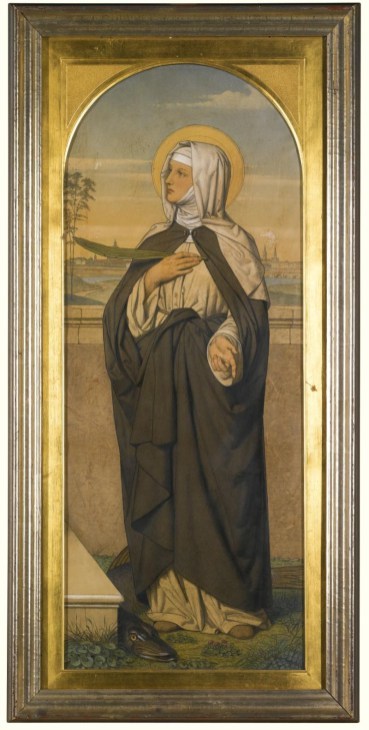
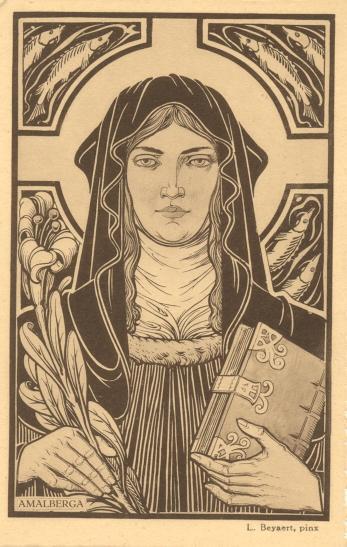
Saint of the Day – 10 July – St Amalberge of Mauberg – also known as: Amalburga of Temse, Amalberga, Amalia, Amelberg, Amelia – (Born in the seventh century in Brabant, Belgium – Died in 690). She is buried beside her husband at the monastery at Lobbes, Belgium and her relics have been in Saint Peter’s abbey church in Ghent, Belgium since 1073. Patronage – against arm pain, against bruises, against fever, of farmers, fever victims, Ghent, Belgium. Attributes – crown, fish, geese, sieve, woman holding a palm and open book, woman standing on a giant sturgeon or other fish, woman with a crown at her feet.
St Amalberga, otherwise Amelia, was born at Brabant and was related to Pepin of Landen. Whether she was a sister or niece, the Bollandists are not sure. She was married to Witger and became the mother of three saints: Gudila, Reinelda, and Emembertus.
The Norman chroniclers speak of her as having been married twice, which seems to be erroneous. She and her husband ultimately withdrew from the world; he becoming a monk and she a nun. There is very great confusion in the records of this saint and of a virgin who came a century after. To add to the difficulty a third St. Amalberga, also a virgin, appears in the twelfth century.
She died in 690 and is buried beside her husband at the Lobbes monastery. Her relics have been in Saint Peter’s abbey church in Ghent, Belgium since 1073. She is known to protect people against arm pain, bruises, and fever.
It is said that she once crossed a lake by riding on the back of a giant sturgeon, which led to her representation on or with a fish.
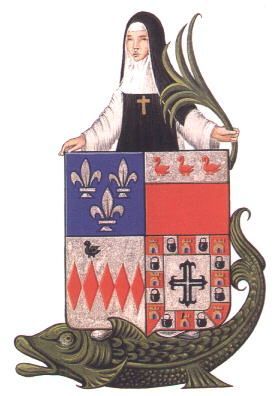
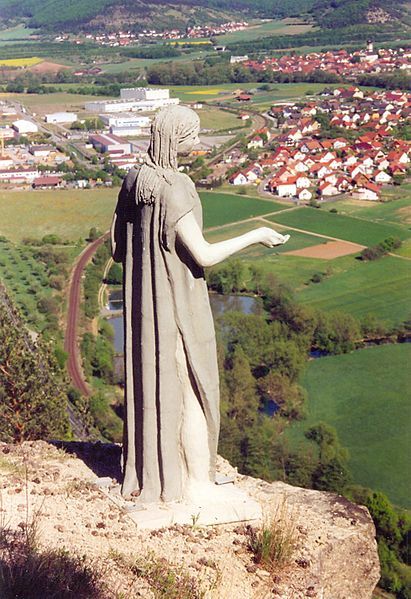
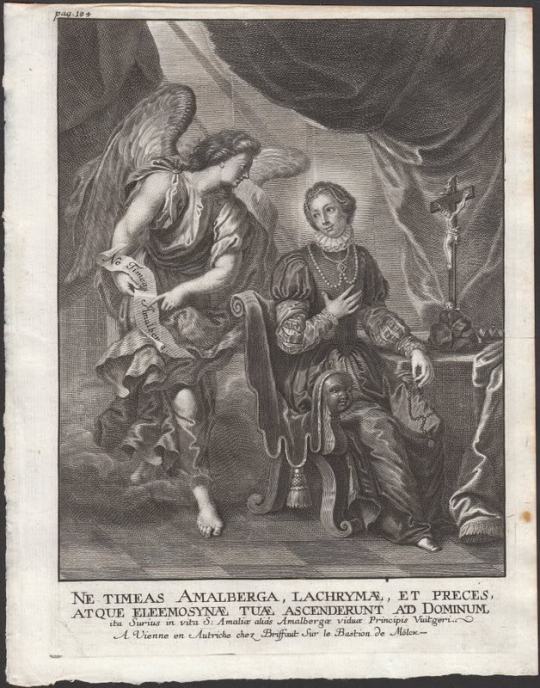

(via AnaStpaul – Breathing Catholic)
34 notes
·
View notes